#Halifax Citadel National Historic Site
Explore tagged Tumblr posts
Text










Benches/Chairs (No. 59)
Kings Landing Historical Settlement, NB (three pics)
Moncton, NB
Halifax, NS (seven pics)
#Moncton#original photography#tourist attraction#cityscape#landmark#architecture#summer 2015#nature#flora#tree#exterior#landscape#travel#vacation#interior#chair#bench#Canada#New Brunswick#Kings Landing Historical Settlement#Halifax#Nova Scotia#Halifax Citadel National Historic Site#Fort George
4 notes
·
View notes
Text

Penultimate day in Halifax.
On the hill: Citadel National Historic Site
2 notes
·
View notes
Text
I have now had two different blogs blaze the same clip to my dash of crosby saying his favourite part about NS is citadel hill in some interview and making it about how the hill is a somewhat infamous cruising spot at night and not to ruin your little gay jokes and your r/p/f nonsense but if you're from the area or literally just been to halifax before I'm sorry it's a pretty basic answer and not suggestive at all. I'm sure tourism ns loved that he said that. It's a giant fucking hill in the middle of downtown with a national historic site fort on top AND the city's iconic clocktower. it's a picnic spot. it's possibly the best view in the city. kids roll down it at high speeds against their parents' wishes. it's the halifax equivalent of saying your favourite part of nyc is central park. that man is not speaking in code to you about how he had gay sex on that hill stop blazing me your unhinged postssssss
#i literally just said to my brother 'i need to rant about something to you so i don't make a post about it'#yet here we are#it's a major landmark not just a gay sex hill only those In The Know would mention I feel like I'm losing my mind here#reilly.txt#i hate the weird vague way i have to type to avoid not appearing in searches i am afraid of sports fans
4 notes
·
View notes
Text
Nova Scotia: South and East shores
Woke up with a full sunshine so the weather finally turned for the better! :) Even when staying in a cabin without having to take care of a tent, I still take about 1.5 hours to get myself sorted in the morning, from drinking my first cup of tea over my daily NY times crossword / wordle / woordle (Dutch version)/CBC news routine, getting dressed, prepping breakfast (apple or oatmeal) & lunch (sandwiches) and packing up, but I did take the time to eat breakfast on the deck in the sun before heading out... Being on the road for so long, I purposely make an effort to slow down where I can especially in the morning; I can always skip something along the way if I'm running out of time.
This day I'm driving east along the south shore of Nova Scotia to its capital Halifax where I'm spending two nights. First stop was the beautiful seaside section of Kejimkujik National Park, where I went for a 8.7km hike along the coastline. The trail starts through the coastal bog which has shrubs and small trees and then opens up to a white sand cove which is pretty on its own... until I spotted the first seals on a little island offshore! Turns out that the area has one of the largest seal concentrations in Nova Scotia, and I ended up seeing over 21 harbour seals and 3 gray seals, which are rarer but easily distinguished by their larger size (up to 2.5m length & 300kg in weight) and horse-like face.

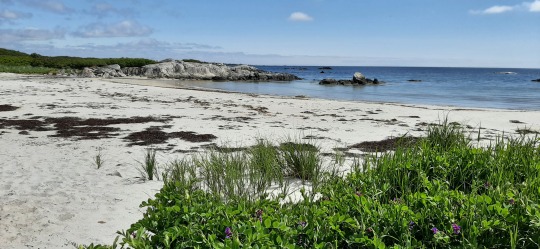

Walking along the various coves, I met the park ranger who says I'll likely see deer and bears on the rest of the trail... "no worries, it already ate a human this morning" 😂 he assured me I got nothing to be concerned about as they mostly eat seaweed... And lo behold, within the next 15 minutes I encounter 4 deer who didn't seem to care about me, and from a vantage point I see from afar (luckily) a black bear combing the beach!! A bit more apprehensive, I continued the hike saying out loud from time to time "hey, I'm here, just a human, you can continue eating your seaweed" 😉 but all good, nothing else happened except that a tiny green snake almost gave me a heart attack when it moved while I was stepping over it, thinking "that's a strange leaf". 🤣

After all the wildlife adventure, I went for a walk through historic Lunenburg, which was recommended as a village that I must visit, but it being a mid-week pre-high season there was hardly anyone there (nor the famous Bluenose replica ship featured on the 10-cent coin) so I was not much impressed honestly. I did pick up yummy fish cakes to eat later at Peggy's Cove which rightly so, features the most visited lighthouse in Canada. Sitting on the big rocks overlooking the Atlantic Ocean makes you feel small!
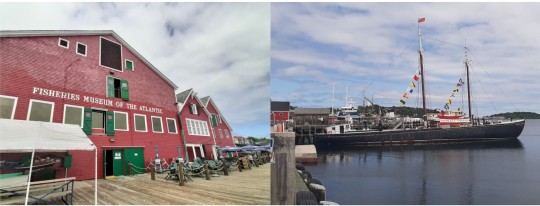


My apartment was in Dartmouth across the harbour from Halifax so that was the perfect excuse to take the ferry to get into town - ferries make me happy and the view from the water is always impressive 😍 - after which it was a steep climb to the clock tower and the Citadel National Historic Site. A guided tour had just started which included a rifle demonstration, the noon cannon shot and the usual titbits of historic info, but I was actually quite moved by a reconstruction of the D-day Juno Beach landing by Canadian troops... Walking through the many obstacles the soldiers would have faced (without the mines & being shot at) makes me appreciate even more the courage those men had that day and during the ensuing battle. The Netherlands was liberated mostly by Canadians, for which we will be forever grateful!


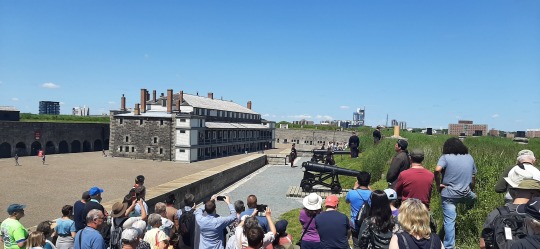
The Art Gallery of Nova Scotia served lighter fare, with amongst others pretty hooked (wall) rugs from Deanne Fitzpatrick depicting local scenes; I have a hooked wall rug myself from Colombia that I love deeply as the various techniques & textures provide a great visual. For who knows the painter Maud Lewis; her entire house was moved and reconstructed inside the art gallery including all original wall paintings and furniture, quite colourful as you can see below. I'm personally not a big fan of her child-like style but apparently her paintings are a hot commodity (I had heard of her as there's many fraud paintings in circulation, not helped by the fact that she used stencils for many recurring motifs and also her husband finished sometimes her paintings). After a morning of culture, high time for a blissful lunch break along the harbourfront which the city has done really well, with many muskoka chairs & hammocks to hang out in, very inviting!

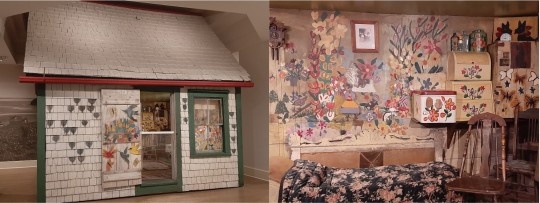

Last touristy thing before sitting down on a patio for a sun-laden beer & snack dinner, was a visit to the Canadian Museum of Immigration at Pier 21, which was the main entry point of transatlantic immigrants coming to Canada by boat. The exhibits really moved me as much rang true to what happened when I came to Canada 14 years ago; from the despair/disbelief of not being able to find a job without Canadian experience, to the "milk & honey" opportunities that I was given to build a new career, buy property and make great & diverse friends, and the pride I felt when I became a Canadian citizen; this is the only country I have never felt like a stranger and that's very meaningful to me. All in all, an amazing day in Halifax!

The next day I drove further east along the south shore and did a couple of hikes; the Salt Marsh Trail uses an abandoned railway track that was built over a causeway across the marsh entrance, so you're walking with water on both sides. On Google Maps it appears the trail goes over water which confused me but is actually true! 😁
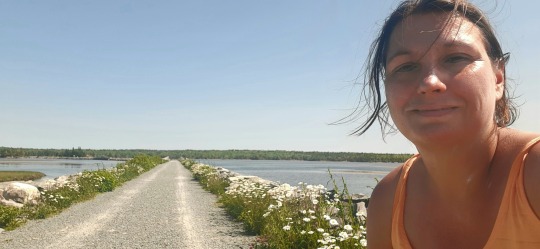

The second was a loop hike at Taylor Head provincial park further east, which has stunning coastline on the west side (the other side was quite boring though looking onto a lagoon). Turned out that the waterproof spraying of my hiking shoes did not work so got wet feet from walking through the bog 😒. At one of the coves, I clearly upset a sandpiper couple presumably with kids nearby, as they made a racket of noise flying low over me while I tried to walk on as fast as possible while keeping my hands over my head in case they would attack...



I decided to skip famous Cape Breton on this trip as I had already been there many years ago (and was not a huge fan despite it being pretty) so instead I beelined across the peninsula to Pictou on the east shore. For at least 40km, there was literally nothing else than a wall of trees (apart from 4 unpaved side roads) which coming from Europe still feels like a miracle to me after all this time. I realised later that the reason why the trees seemed to be more prevalent on this road is that there was no clear-cut on the sides, whereas typically 5-15 meters is cleared on each side of the highways to better see moose/deer before they cross, and increasingly more important, to act as a wildfire break.
Having checked into the motel quite early, I picked up a salad from the grocery store and sat at the Waterside Beach provincial park for a few hours; my very first beach on this trip! Later on, I walked through the village of Pictou which looked cute but dead. At the end of the third week, I'm ready to drive up north again through New Brunswick!


Wildlife: 21+ harbour seals, 3 gray seals, 1 black bear, 4 deer & 1 green snake (all at Kejimkujik), 1 black snake and 2 sand pipers at Taylor Head
SUPs: none
Hikes: one at Kejimkujik, one Salt Marsh Trail, one at Taylor PP.
Distance driven this week: 1373km
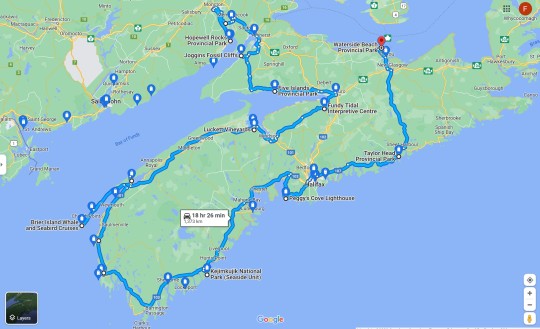
2 notes
·
View notes
Text
Environmental Interpreter
Prior to this course, I had not placed enough importance on the way an interpreter can completely change and influence a persons’ experience of a place. Their ability to “embrace the wonder and beauty of life and share that with others” is admirable and would perfectly describe my ideal role as an environmental interpreter (Beck et al., 2018). I would aim to be updated with the facts to effectively communicate the significance of a cultural or natural site and enrich the visitors’ experience. Interestingly, interpreters can create what Maslow calls a “peak experience”, which gives the sense of being temporarily transported, through their powerful and persuasive communication skills (Beck et al., 2018).
Understanding that individuals have varying learning domains is an essential factor to organize a valuable and satisfactory learning experience for visitors, through incorporating interpretive approaches from the cognitive, affective, and kinesthetic domain (Beck et al., 2018). This is comparative to the “What’s Your Learning Style” quiz, for which my results indicated that I am a 30% auditory, 45% visual, and 25% tactile learner, therefore it is important to approach an interpretation from all perspectives. As an ideal interpreter, I would encourage evoking passion and care for natural sites due to the growing importance of stewardship with the ongoing climate change crisis. As I am a visual learner, I have experienced that getting a brochure with details and facts about a specific location has always enriched my experience, because I am able to explore an area and learn new details. When visiting the Halifax Citadel National Historic Site, we participated in a ghost tour in which the guide created a haunted atmosphere while providing us with historical details about the site. The interpreter’s storytelling ability and engagement made it a unique and worth-while experience, which significantly increased our interest towards the historical aspects. Although he was not an “environmental” interpreter, he still invoked ideal characteristics of one, and used similar principles, including the involvement of the TORE model of thematic communication (Beck et al., 2018).

If I were to choose an optimal place to be an environmental interpreter, it would be in my Town of Caledon, where there are several recreational trails, the Cheltenham Badlands, apple picking orchards, and the Forks of the Credit Provincial Park. The Cheltenham Badlands is one of the most unique places I have ever been to, and it always invokes excitement whenever we drive past. It is a type of place where the beauty speaks or interprets for itself. As my town is where my love of nature excelled, it is where I believe I would be most passionate about being an interpreter. Caledon is known for its environmental aspect, but the continuing increase in the population, causes an urgency to protect the town from urbanization and spread the message of stewardship. My role would focus on this message to encourage people to spend more time outdoors appreciating the breathtaking scenes that nature has to offer. Appreciably, for this ideal position, I would need sufficient knowledge, passion, enthusiasm, and love to act as an effective interpreter.
Citation
Beck, L., Cable, T. T., & Knudson, D. M. (2018). Interpreting cultural and natural heritage : for a better world. Sagamore Venture.
2 notes
·
View notes
Text
youtube
Welcome to our channel! In this video, we explore the Top 10 Things To Do In Halifax Nova Scotia, the vibrant capital of Nova Scotia. Halifax is rich in history, culture, and breathtaking scenery, making it a perfect destination for travelers. Join us as we uncover the best attractions and activities that this charming city has to offer. From strolling along the picturesque waterfront to discovering the fascinating stories of the past at the Canadian Museum of Immigration at Pier 21, we’ll guide you through unforgettable experiences. Explore the stunning Halifax Citadel, indulge in fresh seafood at local restaurants, and enjoy the lively atmosphere of the Halifax Seaport Farmers' Market. Whether you’re a history buff, a foodie, or an outdoor enthusiast, there’s something for everyone in Halifax. Don't miss our top picks for parks, museums, and local events that will make your visit truly special! If you love travel tips and discovering new places, make sure to subscribe for more adventures! Let us know in the comments what your favorite things to do in Halifax are. Hit the like button and share this video with friends who are planning a trip to Nova Scotia! #Halifax #NovaScotia #TravelGuide #Top10 #MustDo #ExploreHalifax #CanadianTravel #VisitNovaScotia ▬▬▬▬▬▬▬▬▬▬▬▬▬▬▬▬▬▬▬▬▬▬▬▬▬▬▬ ➡️ 𝐃𝐢𝐬𝐜𝐨𝐮𝐧𝐭 𝐓𝐢𝐜𝐤𝐞𝐭𝐬 𝐅𝐨𝐫 𝐇𝐚𝐥𝐢𝐟𝐚𝐱 𝐓𝐡𝐢𝐧𝐠𝐬 𝐓𝐨 𝐃𝐨 Peggy’s Cove Small-Group Tour with Transfers: https://gyg.me/0BJjZEmR Small-Group Tour with Citadel and Peggy's Cove: https://gyg.me/aNaEcHsp ▬▬▬▬▬▬▬▬▬▬▬▬▬▬▬▬▬▬▬▬▬▬▬▬▬▬▬ 📌 𝐓𝐢𝐦𝐞𝐬𝐭𝐚𝐦𝐩𝐬: 0:00 Introduction 0:23 Explore the Halifax Citadel National Historic Site 1:42 Stroll Along the Halifax Waterfront 3:58 Visit the Maritime Museum of the Atlantic 5:07 Discover the Halifax Public Gardens 6:11 Take a Day Trip to Peggy's Cove 7:33 Experience the Art Gallery of Nova Scotia 8:38 Wander Through the Historic Properties 9:45 Sail on the Tall Ship Silva 10:54 Visit Point Pleasant Park 12:00 Indulge in Local Cuisine at the Halifax Seaport Farmers Market 13:12 Conclusion: 10 Amazing Things to Do in Halifax ▬▬▬▬▬▬▬▬▬▬▬▬▬▬▬▬▬▬▬▬▬▬▬▬▬▬▬ 𝑫𝒊𝒔𝒄𝒍𝒐𝒔𝒖𝒓𝒆: As an affiliate, I may earn a commission from qualifying purchases made through links in this video's description. They are at no extra cost to you. 10 Things To Do in Halifax Nova Scotia | Travel Hotspots published first on https://www.youtube.com/@BoundlessExpeditions/
0 notes
Text
10 day road trip Canada |5 Unique Itinerary Ideas
Canada, the second-largest country in the world, offers a plethora of breathtaking landscapes, vibrant cities, and rich cultural experiences. A 10 day road trip Canada can be an unforgettable adventure, allowing you to explore the vastness and diversity of this beautiful country. Whether you prefer the rugged beauty of the Rockies, the charming coastal towns of the Maritimes, or the cosmopolitan flair of its major cities, Canada has something for everyone. Here are five unique itinerary ideas for your 10 day road trip to Canada.

The Rocky Mountain AdventureDay 1-2: Calgary to BanffStart your 10 day road trip Canada in Calgary, a city known for its cowboy culture and the famous Calgary Stampede. After exploring Calgary, head to Banff National Park. Spend two days hiking, visiting the Banff Hot Springs, and taking a gondola ride to Sulphur Mountain for panoramic views.Day 3-4: Banff to JasperDrive along the Icefields Parkway, one of the most scenic drives in the world. Stop at the Columbia Icefield and take a tour of the Athabasca Glacier. Spend two days in Jasper, exploring Maligne Lake and Maligne Canyon, and taking a boat tour to Spirit Island.Day 5-7: Jasper to WhistlerContinue your 10 day road trip Canada by driving to Whistler. Along the way, stop at Wells Gray Provincial Park for some waterfall viewing. In Whistler, enjoy outdoor activities such as mountain biking, hiking, and exploring the pedestrian-friendly village.Day 8-10: Whistler to VancouverFinish your Rocky Mountain adventure in Vancouver. Visit Stanley Park, Granville Island, and the Capilano Suspension Bridge. Enjoy the vibrant food scene and explore the diverse neighborhoods of this cosmopolitan city.The Maritime CharmDay 1-2: Halifax to LunenburgBegin your 10 day road trip Canada in Halifax, Nova Scotia. Visit the historic waterfront, Citadel Hill, and the Maritime Museum of the Atlantic. Drive to Lunenburg, a UNESCO World Heritage Site known for its colorful buildings and maritime history.Day 3-4: Lunenburg to DigbyHead to Digby, famous for its scallops. On the way, stop at Kejimkujik National Park for a hike. In Digby, enjoy fresh seafood and take a whale-watching tour.Day 5-6: Digby to CharlottetownTake the ferry from Digby to Saint John, New Brunswick, and then drive to Charlottetown, Prince Edward Island. Visit Green Gables Heritage Place, the inspiration for “Anne of Green Gables,” and explore the island’s charming countryside.
0 notes
Video
youtube
Halifax Citadel National Historic Site | Best Thing To Do In Halifax
0 notes
Text










Benches/Chairs (No. 60)
Halifax Citadel National Historic Site, NS (five pics)
Channel-Port aux Basques, NL
St. John's, NL (three pics)
Cape Spear, NL
#original photography#tourist attraction#cityscape#landmark#architecture#summer 2015#nature#flora#tree#exterior#landscape#travel#vacation#interior#chair#bench#Canada#Halifax#Nova Scotia#Halifax Citadel National Historic Site#Fort George#Channel-Port aux Basques#Newfoundland and Labrador#Cape Spear#St. John's
2 notes
·
View notes
Photo

She likes seeing the darkest and scariest parts. She loves the thrill of it. (at Halifax Citadel National Historic Site) https://www.instagram.com/p/Clz9RuLM5Ac/?igshid=NGJjMDIxMWI=
0 notes
Text
Nova Scotia Bones: a brief listing of famous haunts in Canada’s ocean playground
Nova Scotia is a lobster-shaped granite peninsula that juts out into the North Atlantic on Canada’s east coast. It’s ancient, it’s damp, it’s rocky, and it’s home. It’s also wildly haunted. The impenetrable granite bedrock that we live upon seems to act as its own tomb for the energies of those who departed their earthly vessels on the volatile shores and in the coniferous boreal interior. Or, perhaps, it is our own maritime culture, one that is freckled with memento mori, that adds fuel to these legends that have been passed on through the ages. A culture that lives and dies by the sea is no stranger to tragedy and haunts, eventually one learns to live alongside them. For better or for worse.
I’ve collected a few ghost stories that have stood out to me over the years. When one grows up in Nova Scotia these are a select few that everyone speaks of, some may be lesser known but still thoroughly chilling. These will be arranged in order of popularity.
1. The Young Teazer The Young Teazer was an American privateering schooner who, in June of 1813, would find herself in the waters of Mahone Bay being pursued by the British fleet. Her commander, a Lieutenant Johnston, knew that if he were to be captured he would most certainly hang, and knowing this, he ordered his crew to abandon ship in a major way- the Teazer was exploded, all onboard except for eight perished in the blast. It is now a well-known local legend that on a warm summer’s night, one may still see the reflection of a ship on fire in Mahone Bay’s quiet waters.
2. The forerunner It’s just now occurred to me that I cannot possibly continue without speaking of the forerunner. This phenomenon features extensively within Nova Scotian folklore and is a key aspect of maritime superstition. A forerunner is an omen of death. It may take the shape of the doomed themselves, their scent, a light, an overwhelming sensation of dread directly linked to the individual, a falling photograph of or other object related to the individual, or one’s name being called by the individual. When expecting company, a traditional maritime host will set the large Pyrex kettle on the stove, always containing at least half a dozen teabags, to boil, but sometimes the recently-expected guest may not arrive- ever again. Here are a few selected tales of forerunners from Nova Scotia’s past.
Anyone who is familiar with the series Scary Stories to Tell in the Dark will remember the story of “The Thing.” What they may not know, however, is that this story is based on a real event which happened in Victoria Beach, NS. A Mr. Thorne and his friend, Joe, were out walking at night when they spied behind a neighbour’s house a long, spindly, pale creature dressed in a white shirt, black trousers and black braces peering back at them. Well they had no idea what this creature could be and so they ran back to Joe’s house after it had given them a right spook. Eventually the pair returned only to discover that now the creature was standing atop the fence in the neighbour’s yard, a fence so old it crumbled under a person’s touch, and that’s when it was decided they were done chasing this thing for one evening.
Years later, Joe took ill with consumption and died. Mr. Thorne, his ever-faithful friend, had stayed up with him right up until the very end. Joe’s condition had wasted him away so powerfully he was nary more than skin and bone by the time he’d passed. Mr. Thorne through the years had been hesitant to tell this story at all, for a good reason. Because, he says, toward the end of Joe’s life, lying in bed in his graveclothes, he looked just like The Thing.
In Liverpool, NS, a Mrs. Viola Oickle was seated at the kitchen table playing cards with her friends when she looked up and in the window, plain as day, was her Uncle Ernie. “There’s Uncle Ernie” she said, they’d heard the latch on the door open, but Ernie never showed. After cards she decided she’d go round to Ernie’s house to check on him, and there he was, peeling apples on his front step fit as a fiddle. However, mere hours later, Ernie had died of a heart attack at his home.
Marion Bridge in Cape Breton is home to a wealth of ghost stories, of course the forerunner is one of these. In addition to one’s apparition, three knocks may also be an omen. A Mrs. MacGillivray tells the story of her mother waiting up one night for her father to come home when she heard the sound of a wagon being pulled by horses up the road. They stopped, then came three knocks at the door- which was strange, but her mother figured he may need a hand with something outside. Looking out, she realised no one was there at all. Of course she knew what three knocks meant and feared the worst for her husband. Eventually he returned home in his usual health, but her mother was still confused. A while later the body of a man was found up a nearby road and the men who’d discovered it stopped at the house to change horses at night. They knocked three times on the door, exactly the same sequence of events which transpired when her mother had heard the knocks before.
3. Treasure The province has a storied history of pirates and privateering, so it comes as no surprise that stories of buried treasure are quite popular. As superstition has it, when digging for treasure, one must not speak until the task is done. If a word is spoken, the treasure will never be found. The spirits of pirates go to great lengths to ensure this, one tale tells of a man digging for a hidden treasure with his wife and young daughter. His wife pipes up, “oh would you look at those monkeys!” This is eastern Canada, as such there are no monkeys native to the area. Unsurprisingly, there were no monkeys to be found, and the treasure itself was never uncovered. Speaking of pirates
4. Black Rock Beach/Maugers Beach In Halifax’s early days as the port city it remains today, it was no stranger to pirates. Pirates, however, were not so welcome in Halifax as one may assume. When a pirate was caught in Halifax, they would be hanged and displayed in an iron cage at Black Rock Beach at the harbour’s mouth, or at Maugers (pronounced locally as Major’s) Beach on McNab’s Island a little further out. This is how the latter gained its name as Dead Man’s Beach.
5. Other phantom ships Nova Scotia’s ties to the sea are a major part of its cultural superstition. From “red sky at night” to “never sail if you see a forerunner,” seafaring superstitions are etched into the fabric of life around here. It comes as no surprise, then, that there are so many stories of ghost ships in the mix. One such story comes from 1874, an experience of a Captain Hatfield from Fox River, NS as he was sailing from Cuba to New York. Asleep in his cabin one night, he felt three taps on his shoulder and a voice urging him, “keep her off half a point.” He figured this was the mate or another of his officers, but they each assured him it was not them. He felt the tapping and heard the voice again. As he was growing annoyed, he got up to look around and saw a man climbing up the ladder but was not dressed like the others onboard. Nevertheless, he got up and gave the order to keep the ship off half a point. When morning came, a wreck was spotted half a point off course of his ship, and onboard came Captain Amesbury of the schooner D. Talbot, his wife, child, and his crew. Captain Hatfield recounted the story of the night before to the captain and his wife, to which the wife informed him the man he saw was her father who had passed ten years prior.
A story from Seabright of a fishing vessel that was lost in a sou-easter tells of a captain who’d not turn back as the other boats did, but instead dared the lord to stop him from staying behind. The ship was lost, of course, and for ages onwards sailors would recount seeing a bright light at night that disappeared during the day. It would tack when the respective vessel tacked, but no one ever saw the shape of the boat itself- just its light. But, as sailors do say, one can feel a ship just as one can feel a person nearby.
6. St. Paul’s face in the window This one dates to the time of the Halifax Explosion which occurred on the 6th of December 1917. St. Paul’s Church is the oldest building in Halifax, its foundation having been laid in the year of the city’s founding in 1749. As legend has it, the deacon of the church was standing in the window parallel to the Narrows of the harbour when the French munitions ship, Mont Blanc, exploded. His profile remains in the window to this day and can be seen via Argyle Street.
7. The Black Window House Another Halifax legend, the Black Window House on Robie Street has a long history of superstition. It was built in 1840 for the first elected mayor of Halifax, William Caldwell. It is said to be haunted because of its infamous black window. Local legend states that once a man peered in the window and saw witches dancing their dance of death on the verandah. When the witches caught him spying, they turned the window black.
8. The Town Clock One of Halifax’s most iconic landmarks is the Town Clock on Citadel Hill. This is one of the few surviving round structures designed by the Duke of Kent during his visit to Halifax in the late 18th century. It is said that before the clock was constructed, there existed a well near the site where it stands today. A young girl was reportedly playing near this well when she fell in and died. Her spirit is said to remain in the clock tower to this day.
9. Citadel Hill No discussion of Nova Scotian haunts is complete without discussing Citadel Hill. The Halifax Citadel is today a national historic site, however in the past it was used as a fully-operational military fortification and is one of the best-remaining examples of a star fortress worldwide. Ghost stories from the Hill are many and varied, and some workers have reported seeing strange phenomena themselves such as footprints behind locked metal grates. In the month of October, ghost tours are given by costumed interpreters at the site where famous stories are recounted. Some guests report their hand being held by a smaller, invisible hand, others talk of seeing a ghostly man in the uniform of the 78th Highlanders Regiment walking the grounds only to disappear. It is worth noting that the Citadel never once fired a shot in anger.
10. The Five Fishermen This popular (and pricey) Halifax restaurant serves up fine dining and spirits...not always of the alcoholic variety. Restaurant staff over the years have reported cutlery flying off of tables, seeing apparitions in the washrooms turning the taps on and off, doors closing on their own, and hearing their name called when no one is around. The form of a grey figure is also said to wander down the staircase.
11. The gallows For a time after Halifax’s founding, a gallows was set up on the corner of what is now Lower Water and George Streets. Public executions were a spectacle that could be viewed by all townspeople of all ages. According to local legend, on a clear night the ghost of a hanged man is said to be seen swinging by his neck in the spot where the old gallows used to stand.
12. Dagger Woods I cannot stress enough how creepy and unsettling this area is. In northern Antigonish County there is a forest known as Dagger Woods. In this forest, there is said to live a demon known as the Hidey Hinder who steals unsuspecting visitors to the underworld, the person is never seen or heard from again, supposedly vanishing into thin air. People travelling through the woods report hearing strange and frightening cries that they cannot place, and, understandably, avoid the area afterwards. The woods are the subject of a song by the same name by Nova Scotian folk metal band, The Stanfields.
13. Peggy’s Cove Peggy’s Cove is by far one of Nova Scotia’s most popular tourist destinations. As a lifelong resident of Nova Scotia, I encourage you to visit this beautiful point but please, PLEASE, stay off the black rocks for god’s sake. Anyway, the ghost who is lucky enough to live here is, of course, named Margaret. The story goes that Margaret and her husband settled here after a shipwreck claimed the lives of their children. Margaret was heartbroken, and so her husband decided to cheer her up. He made his way onto the rocks where Margaret would often sit and lament her lost children and performed a dance for her, but it would turn out even worse- he slipped and fell to his death. In a fit of agony, Margaret threw herself off the rocks and into the sea, and her ghost is said to haunt the rocks of Peggy’s Point to this day.
14. Caledonia Mills, or Mary Ellen’s Spook Farm Back in 1922, the MacDonald family lived on a farm in Caledonia Mills situated in Antigonish County. Their adopted daughter, named Mary Ellen, was not held in high regard. A series of fires that had taken place during the winter devastated the family, and Mary Ellen was said to be at the root of them; it was believed she was born of an evil spirit. When she denied these accusations, she was sent to live in an asylum. Her spirit still resides in her farm, and to any unlucky visitor who’d like to bring back a souvenir, they might find that mysterious fires start to ignite in their own home. Best to leave the farm in one piece.
15. Horton’s Cove This is not one that’s widely known to many, however it is a story very personal to myself. On a spot of land in Guysborough County, the remains of a young boy who died in the early 20th century are buried. The grave is unmarked and the boy’s cause of death is unknown. That being said, his presence can be felt in both the field and the hills around where his resting place is said to be, and trust me when I say there is no feeling quite as unnerving.
16. Cole Harbour Poor Farm/Bissett Road Asylum In the 1920s there existed a mental asylum in a quiet part of Cole Harbour, outbound toward the harbour itself. The building is no longer there, said to have burnt to the ground in a fire, however the spirits of its residents can be felt in the vacant lot on the hill where it used to stand. Across the street on the edge of a sprawling field is a small fenced cemetery containing ten unmarked white crosses. It is rumoured that these graves house the remains of children who used to live in the asylum, though it is more likely that these graves were intended for adult residents. It is not yet known whose remains these are.
Dealings with the paranormal and superstition is a way of life for many in Nova Scotia. It is our maritime history and culture which largely feed these beliefs, whether one believes in them is entirely up to the individual themselves. One thing that isn’t so easy to shake, though, is the sensation that there’s something in the trees or that field over there. Say, what’s on the water?
43 notes
·
View notes
Text

Historical reenactors in uniform at the Halifax Citadel National Historic Site, Nova Scotia.
#halifax citadel#halifax#nova scotia#war of 1812#canadian history#military history#dressed to kill#dream vacation tbh
14 notes
·
View notes
Photo

The noon gun. #exploreNovaScotia #exploreCanada #Halifax (at Halifax Citadel National Historic Site) https://www.instagram.com/p/CS-xA1fgFmy/?utm_medium=tumblr
1 note
·
View note
Text
20 Tourist Destinations in Canada by Ashish Dewan
1. Vancouver, British Columbia
Vancouver is so beautiful that it’s become a hit with filmmakers: so much so that the city has the nickname Hollywood North. Among the most popular attractions here are Stanley Park, Granville Island and the Capilano Suspension Bridge.
2. Whistler, British Columbia
Whistler is North America’s largest ski resort and was the host mountain resort for the 2010 Winter Olympics held in Vancouver. Summer activities here include hiking, mountain biking, rock climbing and golf.
3. Quebec City, Quebec
Founded in 1608 but first settled in 1535, Quebec City is one of North America’s oldest European settlements. Attractions here include the historic Old Town, which is a UNESCO World Heritage Site, as well as the Château Frontenac and, in winter, the Ice Hotel.
4. Montreal, Quebec
If you can see only one Canadian city in 2017, Montreal should be at the top of your list. Home to attractions such as the Notre-Dame Basilica and Old Montreal, Canada’s second most populous city celebrates its 375th anniversary this year.
5. Toronto, Ontario
The joke may be that Toronto is New York City run by the Swiss, but the city on the shores of Lake Ontario is a vibrant, multicultural city with fascinating museums, stunning architecture, beaches and a great restaurant scene. The best-known attraction is the CN Tower, which you can now dangle off of.
6. Canmore, Alberta
Canmore is one of the gateways to Banff National Park but is also a destination in its own right. The town in the Canadian Rockies is an outdoor lover’s paradise and also hosts a variety of festivals and the Canmore Highland Games during the year.
7. Kelowna, British Columbia
Located on Okanagan Lake, Kelowna is in the heart of the Okanagan wine country. Outdoor pursuits such as boating, hiking and golf are popular in summer while the nearby ski resorts attract visitors in winter.
8. Niagara Falls, Ontario
A popular honeymoon destination, Niagara Falls is home to attractions such as a butterfly conservatory that is one of the largest in North America. The main attraction though is the set of three waterfalls the city is named after.
9. Cape Breton Island, Nova Scotia
Cape Breton Island is home to a unique style of fiddling, a rich Scottish Gaelic heritage and the Alexander Graham Bell National Historic Site. The island is also very scenic, with attractions like the Cabot Trail and the Cape Breton Highlands National Park.
10. Stratford, Ontario
Like its namesake in England, Stratford is located on the banks of a river named Avon. The city is famous for its Shakespeare festival, its music festivals and for being the hometown of Justin Bieber.
11. Calgary, Alberta
The oil industry has made Calgary a prosperous and multicultural city. However, its location on the edge of the prairies means it’s still cowboy country, and the Calgary Stampede is the city’s most famous – and raucous – event.
12. Ottawa
Canada’s capital is also its most educated city and home to most of the country’s national museums. The main attraction here is Parliament Hill, and in winter, a must-do is to go skating on the Rideau Canal.
13. Edmonton, Alberta
Edmonton has a vast park system with hiking and biking trails and is one of the cities where you may be able to spot the Northern Lights on a clear winter’s night. Other attractions include the TELUS World of Science, the Ukrainian Cultural Heritage Village and North America’s largest shopping mall.
14. Winnipeg, Manitoba
Winnipeg hosts some great festivals during the year and is also a popular destination for sports lovers. The city’s architecture and museums are among its greatest attractions, with the Canadian Museum for Human Rights the ultimate showcase for both these aspects.
15. Mississauga, Ontario
Mississauga is really a suburb of Toronto, and its long shoreline makes it perfect for waterfront dining and shopping. With plenty of amusement parks and festivals, Mississauga is especially popular for family vacations.
16. Victoria, British Columbia
Victoria’s location on Vancouver Island, its many stunning beaches and its Mediterranean climate make it one of Canada’s best boating destinations. Historic architecture, the Royal BC Museum and Butchart Gardens are some of the city’s other attractions.
17. London, Ontario
London is located on the banks of the Thames River – the one in Ontario. Festivals like the Sunfest world music festival and the London Rib-Fest as well as attractions like Springbank Park and the Fanshawe Pioneer Village draw many visitors in summer.
18. Hamilton, Ontario
Hamilton has been used as a filming location for movies as diverse as Hairspray and the Resident Evil franchise. The city’s attractions are diverse too and include Dundurn Castle, the Canadian Warplane Heritage Museum, the Bruce Trail, African Lion Safari and more than 100 waterfalls.
19. Richmond, British Columbia
Richmond is located just south of Vancouver, at the mouth of the Fraser River. With more than half of Richmond’s population of Asian descent, this is a fantastic destination for lovers of Asian cuisine. The city is also home to great shopping and the impressive International Buddhist Temple.
20. Halifax, Nova Scotia
As a busy port city, many of Halifax’s attractions are related to the sea. They include North America’s oldest lighthouse as well as the Maritime Museum of the Atlantic and the Canadian Museum of Immigration at Pier 21. Citadel Hill with Fort George is one of the city’s most well-known historic sites.
1 note
·
View note